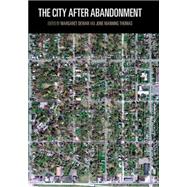
Note: Supplemental materials are not guaranteed with Rental or Used book purchases.
Purchase Benefits
What is included with this book?
| Introduction: The City After Abandonment | p. 1 |
| What Does the City Become After Abandonment? | |
| Community Gardens and Urban Agriculture as Antithesis to Abandonment: Exploring a Citizenship-Land Model | p. 17 |
| Building Affordable Housing in Cities After Abandonment: The Case of Low Income Housing Tax Credit Developments in Detroit | p. 41 |
| Detroit Art City: Urban Decline, Aesthetic Production, Public Interest | p. 64 |
| What Makes a Difference in What Cities Become After Abandonment? | |
| Decline-Oriented Urban Governance in Youngstown, Ohio | p. 87 |
| Targeting Neighborhoods, Stimulating Markets: The Role of Political, Institutional, and Technical Factors in Three Cities | p. 104 |
| Recovery in a Shrinking City: Challenges to Rightsizing Post-Katrina New Orleans | p. 133 |
| Missing New Orleans: Lessons from the CDC Sector on Vacancy, Abandonment, and Reconstructing the Crescent City | p. 151 |
| What Helps or Hinders Nonprofit Developers in Reusing Vacant, Abandoned, and Contaminated Property? | p. 174 |
| Targeting Strategies of Three Detroit CDCs | p. 197 |
| What Should the City Become After Abandonment? | |
| Strategic Thinking for Distressed Neighborhoods | p. 227 |
| The Promise of Sustainability Planning for Regenerating Older Industrial Cities | p. 244 |
| Rightsizing Shrinking Cities: The Urban Design Dimension | p. 268 |
| Planning for Better, Smaller Places After Population Loss: Lessons from Youngstown and Flint | p. 289 |
| Notes | p. 317 |
| List of Contributors | p. 373 |
| Index | p. 379 |
| Acknowledgments | p. 387 |
| Table of Contents provided by Ingram. All Rights Reserved. |
The New copy of this book will include any supplemental materials advertised. Please check the title of the book to determine if it should include any access cards, study guides, lab manuals, CDs, etc.
The Used, Rental and eBook copies of this book are not guaranteed to include any supplemental materials. Typically, only the book itself is included. This is true even if the title states it includes any access cards, study guides, lab manuals, CDs, etc.